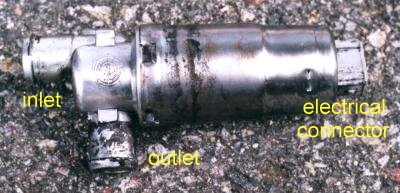ISV stands for Idle Stabiliser Valve. What it does is, um, stabilise the idle speed of the engine. Present on all CIS-E vehicles, it is controlled by the fuel/air ECU, in response to the temperature sender in the upper radiator hose flange, the engine speed information from the coil/tach signal, and the idle switch on the throttle body. The ISV is placed in such a way that it acts as a valve between two hoses, one of which is connected ahead of the throttle body and one after it. Thus it can allow air to bypass the throttle butterflies to maintain an appropriate engine speed. Normally, the ISV is partially open. When it is called upon to function, the ECU sends it a pulsed signal which rapidly opens and closes it. This is measured as a duty cycle, or percentage of time it is open. When the engine is warm, not much air is required to keep the engine running and the ISV is supposed to have a duty cycle of 27%, which is just about at the minimum possible (the ECU only runs down to 25%). When the engine is cold it takes more air (and more fuel, also controlled by the ECU) to keep it idling, and the ISV is run at a higher duty cycle to manage this. This is one of the advantages in terms of economy of CIS-E over the older more mechanical CIS. The older system manages the enrichment and air increase via two internally heated devices whereas CIS-E uses direct measurements of engine parameters and adjusts accordingly. The most common "failure" mode exhibited by the ISV is to get clogged up with slowly accumulating oil and gunk (which is drawn into the intake tract by the PCV system) to the point where it will not respond properly to the ECU control. Since it is often a matter of "getting it going," this will occur at the most inconvenient time, that is when the engine is cold and the ISV has had time to get stuck in its congealed state. So if you have to depress the accelerator to keep the engine running when cold, or if your idle is erratic and unstable, fixing the ISV is a good place to start troubleshooting. (A tune up couldn't hurt either! How old are those plugs?) To fix the ISV, you clean it. Undo the hose clamps, unplug the wire connector, and wrestle it free of its mooring devices. Bring it somewhere well lit and reasonably well ventilated and use a bunch of brake cleaner to wash it out. It does not hurt and might just help a little to apply 12 volts to its terminals intermittently, activating its little solenoid and causing it to flutter open and shut. This will help get all the gunk out of its nooks and crannies. Reinstall it carefully, making sure the electrical contacts are clean and protected from future corrosion with a little silicon dielectric grease, and see if it helps! (except they are usually rather corroded, and nasty with oil and dirt)
This is where it goes, on some cars anyway:
|

